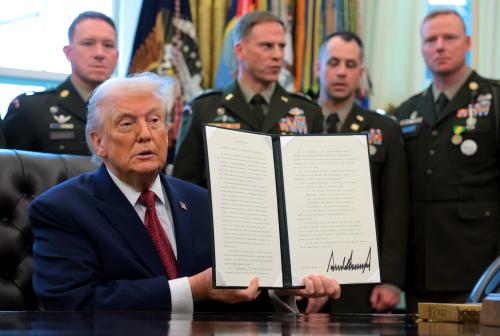List prices for branded prescription drugs in the United States are three times higher than the prices paid in other wealthy countries. This discrepancy has arisen primarily because other countries have systematic and nationwide or quasi-nationwide mechanisms for regulating reimbursement rates for prescription drugs, while in the U.S., pricing has been less centralized and less regulated. The result is that the U.S. spends far more on drugs than other countries, and for most drugs a very large share of net revenue is from U.S. payers.
As American policymakers continue to consider ways to lower U.S. costs for drugs, many are doing so by looking to the prices paid in other countries. This piece provides a framework for understanding the potential role of international prices in the U.S. system, describes the recent history of policymaking on these issues, and looks ahead to what could come next.
What role can international reference prices play in U.S. drug pricing?
Around the world, prices for prescription drugs vary. “International reference pricing” (IRP) is a method for aggregating information about what other countries pay for drugs to inform pricing choices within one’s own country. The use of IRP is quite common. Nearly all member countries of the European Union and most Organization for Economic Co-operation and Development (OECD) countries look to some sort of IRP, generally in the context of negotiations with pharmaceutical manufacturers and not as direct price setting mechanisms.
The U.S. government does not currently have a systematic way of incorporating IRP into prices paid by any payer or in any federal program. There is widespread disagreement about the value of IRP, and this disagreement does not cut cleanly across party lines: Some Congressional Democrats and presidents of both parties have called for IRP use along with advocates for drug pricing reforms, while many others in Congress and other stakeholders have been skeptical. Concerns include a view that the U.S. should develop its own policies for the valuation of drug products and not “import” those from other nations with different traditions and norms. In fact, some health economists have called the idea of applying IRP in the U.S. “a lazy, misguided bipartisan plan.” Others are concerned with built-in biases in the valuations used in other countries that might harm people with disabilities or other marginalized groups. That is, some advocates for people with severe illnesses and disabling conditions are concerned that the use of IRP may undervalue products that are heavily used to treat those populations and thereby result in limited access. Still, others are concerned with distorted incentives that drug companies might face if the U.S. were to use IRP more systematically. Specifically, the experience with the use of IRP in Europe has resulted in pharmaceutical manufacturers delaying product launches and limiting supply to low price countries used in IRP.
Supporters of the use of IRP in the U.S., on the other hand, believe it is an effective tool that can lower costs. Many view IRP as the simplest method to set a benchmark for lower prices. Similarly, given fears about regulatory capture and general dysfunction in the American political system, IRP can offer a way to “piggyback” off more functional systems to establish a quasi-objective benchmark for pricing efforts.
Still others look to IRP not only as a tool to lower drug prices in the United States but also to increase prices paid in other countries and put an end to perceived “freeloading.” A line of economic research has argued that the application of IRP would lead to increases in pharmaceutical prices in comparator nations precisely because of the potential supply response of pharmaceutical manufacturers. The theory suggests that in order to head off supply disruptions and ensure timely product launches, nations with lower drug prices would negotiate higher prices with the industry. This theory relies on several assumptions, including that observed prices and transaction prices for prescription drugs are the same. If they are not, the unobserved transaction prices need not change even if the observed, announced, or list prices do respond to the IRP rules. As is well known in the United States, this need not be the case. The American experience with Pharmacy Benefit Managers (PBMs) underscores the fact that while list prices are readily observable, industry participants enter into secret discounting and rebate arrangements, creating a wedge between the list and transaction or net price where the transaction price is largely unobservable. This serves to weaken the link between IRP and foreign transaction prices. The experience in Europe is instructive, as several countries have created arrangements that set a publicly reported list price and a secret set of rebates to most payers. In the past, only Germany has reported transaction prices, although that may be revised. Likewise, other mechanisms, such as manufacturer donations to other sectors of a nation’s health system (hospitals, for example), would serve a similar purpose of reducing the “effective” transaction prices. The end result of this type of conduct would be the failure to induce price hikes abroad.
Whatever one’s goals, conceptually, an IRP could be used in three distinct ways by the U.S. government: as a direct price cap, as a factor in negotiation, or as a source of additional transparency:
- Direct price caps: An international reference price could be used to cap the amount that is paid for a given prescription drug—either market-wide or in a particular market segment. For example, policymakers could simply cap reimbursement at list prices nationwide. Alternatively, they could incorporate IRP into the calculation of rebates and discounts paid in some market segments, which would function as a price cap for prices under those programs. Policymakers could set reimbursement rates under a market segment to be equal to a calculated reference price. Similarly, policymakers could also use IRP to establish a “ceiling price” that is the maximum figure the government can agree to in what is otherwise an open negotiation. Any of these uses could be implemented in a variety of ways.
- Negotiation factor: The U.S. government could use IRP as a factor in its own negotiations with pharmaceutical manufacturers, e.g., in the Medicare drug price negotiation program. In this way, IRP informs government negotiators’ understanding of an appropriate price based on what other countries have arrived at. Internationally, this is the predominant way that other countries incorporate IRP into their own efforts. There would be more or less prescriptive ways to define the use of such a factor, such as linking to initial offer development, prioritizing consideration of IRP, or offering it as one factor among many.
- Transparency: Some policymakers are interested in ways to bring more transparency to prescription drug pricing information or to communicate price targets that attempt to “name and shame” certain pricing choices by drug manufacturers. IRP could be incorporated into any of these efforts. This would be less powerful than other approaches but could provide some marginal degree of support to payers’ efforts to lower drug prices.
Regardless of how IRP is used, the methodology for actually determining the price matters. The first choice policymakers face is selecting comparator countries that form the reference price. In countries that use IRP today, the comparators are typically a subset of OECD countries with similar GDP per capita, and the number of bundled countries ranges from four to 24. An alternative approach is to use only a single country, though that creates significant risk of gaming. In addition to selecting countries with similar economies, policymakers may seek to select countries that apply a set of values in setting prices that translate to their own health care context. Most countries determine prices in a way that is intended to be reflective of the clinical value of the drug. For example, some countries may look to “Quality-Adjusted Life Years” (QALYs), a metric intended to measure outcomes across many different disease states. However, some in the U.S. have raised concerns that this approach could undervalue treatments for certain kinds of conditions and discriminate against people with disabilities. Therefore, policymakers may wish to consider how health value is measured in other countries and select comparators accordingly. The selection of countries in this way can bring IRP closer to U.S. values and preferences. Countries that use IRP also consider similarity in health insurance systems and data availability in potential comparator countries. However, a unique challenge of IRP adoption in the United States is that most brand-name drugs are launched first in the U.S. Initially, that is, there may not be a reference price to calculate, where the product is not yet available in the set of reference countries.
Another choice policymakers face is selecting the set of drugs for which to use IRP. As discussed below, previous U.S. efforts to implement IRP have all focused on a subset of high-cost branded drugs. Going forward, any effort to implement IRP in the U.S. will need to confront potential interactions between the Medicare drug price negotiation program and the set of products selected for IRP.
Once comparator countries and the types of drugs are selected, policymakers need a way to aggregate prices into a single price. One approach is to use the single lowest price, which the Trump administration has referred to as a most favored nation price. More common is the use of an averaging methodology. Averaging usually requires adjustment for factors such as differences in GDP per capita, exchange rates (typically using Purchasing Power Parity or a PPP index), drug sales volume, and population size. The use of an average is typically based on list prices. As noted earlier, this may overstate transaction prices. In the near term, this may be less important for establishing U.S. prices given the large differences between U.S. brand-name drug prices and those across other OECD nations. In the longer term, reliance on list prices may be a source of gaming if other countries can increase their list prices while maintaining lower net prices, and policymakers may consider whether additional sources of information (such as manufacturer-reported net global revenues) can be used to make adjustments if necessary.
Alongside construction of IRP, it is necessary to establish updating requirements. That means a duration of price applicability must be selected. In addition, IRP that focuses on brand-name prices also includes a reconsideration trigger for when product exclusivity periods end. In the U.S., for small-molecule drugs this often implies generic entry and price reductions of between 60% and 80% over the course of a year or two. Additionally, an inflation adjustment is usually built into IRP to account for general economy-wide price changes (CPI-U in the U.S. would be the most obvious choice). Finally, the reference price itself need not be the price paid. For example, under the proposed Elijah E. Cummings Lower Drug Costs Now Act, discussed in more detail below, a multiplier was used in conjunction with IRP. In that case, a ceiling price of 120% of the reference price was proposed. The advantage of using such a multiplier is that it allows policymakers to “dial” IRP to address market adjustment processes and other market dynamics along with cost savings goals.
The potential savings from implementation of IRP are large given the wide gulf between U.S. prices and the prices in other countries. The Congressional Budget Office (CBO), the RAND Corporation, the Council of Economic Advisors, and others have all examined this question. CBO specifically modeled using IRP to establish a ceiling price in the context of price negotiation in Medicare that was equal to 120% the price in a set of countries that included Australia, Canada, France, Germany, Japan, and the United Kingdom; this was estimated to result in prices that were 32% of prices at the time, and savings to the federal government of $450 billion over 10 years. A recent report from the RAND Corporation indicated that prices among 33 comparator countries were about 36% of U.S. manufacturer prices in 2022.
Lessons learned from recent U.S. policy efforts
In recent years, policymakers of both parties have made major efforts to incorporate robust IRP into U.S. prescription drug prices: the Democratic-led Elijah E. Cummings Lower Drug Costs Now Act (generally referred to by its bill number, H.R. 3), which passed the House of Representatives in 2019, and proposals from the first Trump administration to base payments for prescription drugs under Medicare Part B on international prices.
Trump administration’s 2018 ANPRM
In October 2018, weeks before the midterm elections, the Trump administration released an Advance Notice of Proposed Rulemaking (ANPRM) that described a proposed methodology for using IRP in Medicare. Specifically, the ANPRM focused on fee-for-service payments for physician-administered drugs in Medicare Part B, where Medicare pays providers 106% of the average sales price of the drug after the provider has purchased drugs in the nationwide drug supply chain (otherwise known as the “buy and bill” model). The Trump administration proposed that—in certain regions of the country and for certain drugs—it would instead reimburse providers with a flat administration fee, and the providers would receive the drugs from intermediate vendors that were reimbursed by Medicare. Medicare would pay the vendors an amount that was calculated based on international prices for the drugs that were part of the program, and vendors would be responsible for purchasing drugs from manufacturers (at prices consistent with IRP, at least in theory) and for setting up systems to distribute the drugs to providers. In this way, IRP would function as a direct reimbursement cap on Medicare Part B payments to those vendors. The ANPRM proposed to use the authority of the Centers for Medicare and Medicaid Innovation (CMMI) to operate a demonstration program testing the new approach and indicated the agency expected to issue a full proposed rule in 2019 with a potential model starting in 2020.
The ANPRM was limited in scope, applying only to certain drugs in certain geographic areas, but it nonetheless raised several policy, legal, and operational questions:
- Effectiveness and access implications of the demonstration: The core idea of the demonstration was that in some geographic areas providers would continue obtaining drugs for all of their patients at higher prices in the existing supply chain, while in other geographic areas drugs for Medicare patients would flow through vendors who obtained the drugs from manufacturers at lower prices based on IRP and drugs for non-Medicare patients would move through the existing supply chain at higher prices. Many observers raised concerns about whether drug manufacturers would be willing to sell drugs to vendors at the lower prices in the first place. While a sale to a vendor at an IRP-based price that was profitable for the vendor would be the only way to reach the Medicare patients in the selected geographic areas—and so refusing to sell to vendors would mean losing some patients—manufacturers could hope that a sufficient number of patients would travel outside those areas to receive drugs from a different, non-affected provider. Further, manufacturers might be concerned that drugs sold to vendors would “spill” into the rest of the supply chain or that selling at lower prices to vendors could affect rebates for other payers, such that they might find it attractive to forego sales to vendors. If that happened, of course, it would create major access issues for Medicare beneficiaries (something the Trump administration claimed at the time would not occur).
- Obtaining needed data: The ANPRM described IRP based on data from Austria, Belgium, Canada, Czechia, Denmark, Finland, France, Germany, Greece, Ireland, Italy, Japan, Netherlands, and the United Kingdom. As noted earlier, available data are limited to list prices for nearly all countries, and many OECD nations have put into place confidentiality agreements that would limit the ability of the U.S. to obtain transaction price data from manufacturers. In addition, the formulations and delivery mechanisms used for products sold abroad are frequently not strictly comparable to the products launched in the U.S. Moreover, 40% of drugs launched in the U.S. between 2015 and 2024 had not yet been brought to market in the European Union countries at the time of their launch and in many cases for several years after, which complicates applying IRP to new drugs. It was not clear how the ANPRM model would overcome these challenges.
- Legal issues: Because of the early-stage nature of the ANPRM, it was not subject to challenge in court by applicable stakeholders. However, many of the above-described issues relate to legal questions that would arise if a final rule was issued. Some of the effectiveness concerns regarding gaming across geographic areas could be resolved through using a nationwide model. The issues regarding access to pricing data and concerns that manufacturers will not make the drug available at the lower reference price, resulting in potential access concerns, could be resolved, at least partially, with additional legal authority from Congress. CMMI’s existing legal tools to address those issues are more limited.
Congressional Democrats’ H.R. 3
A few weeks after release of the ANPRM, Democrats took control of the House of Representatives in the midterm elections and began working on a piece of legislation that went beyond the scope of the ANPRM. The Elijah E. Cummings Lower Drug Costs Now Act, H.R. 3, proposed to allow Medicare to directly negotiate prices with drug manufacturers for certain brand-name drugs in Medicare, including both physician-administered drugs in Part B and pharmacy-dispensed drugs in Part D. By acting through legislation, including by creating a way for Medicare to directly negotiate with the manufacturers, H.R. 3 avoided many of the fundamental challenges facing the ANPRM as a tool to lower drug prices.
Further, in order to ensure that the negotiations between Medicare and pharmaceutical manufacturers resulted in meaningful savings, Congress proposed that the negotiation would be bound by a “ceiling price”—a maximum price above which Medicare could not make or agree to an offer. Under H.R. 3, this ceiling price was based on IRP: 120% of the average prices across six peer countries, Australia, Canada, France, Germany, Japan, and the United Kingdom. This use of IRP served as a price cap, though Medicare was free to negotiate prices lower than this cap and could use information from individual countries to inform its judgement about the appropriate price for the drug.
The Trump White House opposed H.R. 3, arguing that it would “undermine access to lifesaving medicines,” was a “price-fixing mechanism” that “impose[d] price controls,” that the fines associated with failure to negotiate were excessive, and that there would be damaging effects on innovation.
Ultimately, H.R. 3 passed the House in December 2019 with the votes of all voting Democrats and two Republicans. The Republican-controlled Senate never seriously considered legislation like H.R. 3 or policies that incorporated IRP (though the Senate Finance Committee did refer out bipartisan drug pricing policies that did not involve negotiation or consideration of international prices). Years later, in August 2022, Congress would pass and President Biden would sign the Inflation Reduction Act (IRA), which allowed Medicare to negotiate drug prices following a similar basic negotiation framework as H.R. 3, but the IRA used a ceiling price that did not reflect IRP, as discussed further below.
Trump administration’s 2020 executive order and interim final rule
The Trump administration returned to this issue in September 2020, just before the 2020 election. President Trump issued an Executive Order that directed Medicare to implement a policy along the same lines as the 2018 ANPRM but with a more aggressive IRP: Instead of using an average of other countries’ prices, the administration was to base their approach on a “most favored nation” model that looked to the lowest price in a group of comparator countries.
At the end of November, after the election, the administration released an interim final rule (IFR) (i.e., a final rule undertaken without a proposed rule preceding it) along the lines envisioned by the Executive Order. The premise underlying the IFR was the same as the premise underlying the ANPRM: Tie reimbursement rates under Medicare Part B to the lower prices paid in other countries for the same drugs. The administration still sought to advance this goal through a CMMI demonstration model, but critical aspects of the IFR and its potential consequences differed from the ANPRM. First, the IFR abandoned the vendor model envisioned in the 2018 ANPRM, instead implementing IRP through Part B’s current buy-and-bill model. That is, payment to health care providers would no longer be 106% of ASP but would instead be an amount based on international prices. Second, the IFR would have applied nationwide instead of applying in only parts of the country. Third, the IFR changed its method of IRP, moving from the 16 countries used to identify a target price in the ANPRM to a system of choosing the lowest price of any OECD country with a GDP per capita at least 60% of the United States. Importantly, the IFR did not solve key data questions that had arisen in the ANPRM, including regarding the collection of pricing data. Some of the IFR’s suggestions were not credible on this point. For example, the IFR favorably discussed a World Health Assembly resolution envisioning that World Health Organization (WHO) member states could share net price data. The rule does not, however, note that then-President Trump had begun the process of withdrawing the U.S. from the WHO.
Under the IFR, implementation of the new payment system was to begin just a few weeks after its issuance, on January 1, 2021. Health care stakeholders immediately took to the courts to block implementation, arguing (among other claims) that the use of an IFR violated the Administrative Procedure Act (APA) and that the rule was not a lawful CMMI demo. Multiple federal district courts agreed, reasoning on procedural grounds that the administration had not followed the required notice-and-comment rulemaking process under the APA. The rule was enjoined before it was implemented, and the Biden administration ultimately rescinded the IFR, citing the legal challenges.
Procedural issues aside, the structure of the 2020 policy mitigated some of the challenges that plagued the 2018 proposal but exacerbated others. By shifting to a nationwide model rather than one in particular geographies, the new approach addressed concerns that manufacturers would refuse to sell at IRP-level prices for the specific reason that they hoped patients would obtain drugs from unaffected providers in nearby locations. Still, manufacturers might keep prices high and hope that providers would continue to provide the drug to Medicare patients at a loss (e.g., because the provider can generate revenue from other services the patient receives or generate revenue from the drug in other market segments). Another possibility, though, was that manufacturers would keep their prices high and providers simply wouldn’t buy and wouldn’t administer the drugs to Medicare enrollees. Indeed, Medicare’s actuaries concluded that this was quite likely under the 2020 model, estimating that up to 19% of Part B drug utilization might be eliminated because patients could no longer access the drugs in question from their providers.
In addition, some of the changes made between the 2018 ANPRM and the 2020 rule created new legal vulnerabilities beyond the procedural infirmities of the notice-and-comment process. For example, the complaints against the IFR argued that it exceeded CMMI’s statutory authority and did not qualify as a “test” of a “model,” in part due to the IFR’s mandatory, nationwide features.
Where we stand today
Despite the challenges embedded in this recent history, policymakers remain interested in IRP. Indeed, President Trump has issued two Executive Orders directing the administration to consider new steps along this path. An April order directed the administration to take “appropriate steps” to implement rulemaking that would lower drug costs in Medicare through a CMMI demonstration, a likely reference to a renewed IRP-based model like the 2020 policy. A second order in May more specifically referenced the most-favored nation approach, though it provided limited detail on the path forward. That second order discussed a number of steps:
- Consumer purchasing programs: The administration should facilitate “direct to consumer” purchasing programs that make drugs available at prices consistent with IRP. This may be inspired by existing programs that sell GLP-1 medications to consumers with a prescription who are paying cash at prices significantly below what is otherwise available in the U.S. (though still significantly above international prices). It is unclear how well this model will translate to drugs that, unlike GLP-1 medications, are almost always covered by insurance.
- Price targets: The administration is directed to establish “price targets” derived from international prices and, within 30 days of the executive order, communicate them to pharmaceutical manufacturers as the goal to voluntarily bring down their prices in the U.S. This represented a potential IRP-based “name and shame” voluntary approach, where policymakers could assemble data on international prices in order to guide decisions of American payers and bring attention to high prices. However, the administration has not implemented this directive in a way that is likely actionable by payers or manufacturers, issuing a brief statement that the target price was the lowest price in any OECD country with a GDP per capita that is at least 60% of the United States’, without making available any accompanying data.
- Rulemaking: The administration is to consider rulemaking to “impose” IRP if the price targets above do not achieve “significant progress.” This is likely consistent with the prior Executive Order’s reference to CMMI rulemaking, though not specified in the document itself.
Taken together, this suggests we might see a new proposed rule with a similar structure to the 2018 ANPRM and 2020 IFR in the months ahead. As policymakers develop this proposal, they will need to wrestle with all of the challenges that have plagued prior iterations. Most critically, they must make design choices that are mindful of the need to preserve access to drugs that are targeted. By regulating payments to providers in Medicare Part B (and not the prices drug manufacturers charge when they sell drugs to those providers), any model runs the risk that manufacturers may simply opt not to sell at a price that is viable for the providers. Model design should calibrate its approach to minimize this risk. For example, policymakers may wish to focus on preventing spillover outside of Medicare, designing the policy so that revenue impact is manageable for manufacturers, and avoiding losses for providers.
Policymakers will also need to ensure access to needed data. But other nations will likely respond by reducing pricing transparency through secretive discounts, rebates, and grants, thereby limiting gains from IRP especially in the medium-to-longer term. The ability to hide transaction prices also limits the Trump administration’s goal of forcing other nations to raise their prices and limits what has been termed “freeloading.”
Finally, any model will continue to carry significant legal risk. CMMI’s Medicare authority is fundamentally designed to test new approaches for payment. Changes of the sort contemplated here will strain the concept of a “test.” Carefully defining a control group—e.g., through the use of limited geographies as the 2018 ANPRM attempted or through other limitations like specific drug targets—will be necessary but may not be sufficient. This administration appears to pursue litigation strategies with the aim of expanding executive power in ways that go beyond previous administrations, and it may be willing to pursue an aggressive strategy here. More novel administrative legal claims involving, for example, the major questions doctrine or the non-delegation doctrine may also be likely to arise.
Of course, an alternative path remains available if policymakers wish to incorporate IRP into U.S. prices for prescription drugs. Specifically, as noted above, in 2022 in the IRA Congress enacted a version of Medicare drug price negotiation that did not incorporate IRP. But Congress could amend the negotiation statute to strengthen the program through consideration of international prices, incorporating IRP into a new ceiling price and effective price cap. Alternatively, and more in line with international experience in which IRP is generally only one factor in price setting, Congress could direct Medicare to consider IRP in its negotiations without requiring any specific outcome in the negotiation. The agency could be given authority to compel manufacturers to submit the information necessary to calculate a meaningful reference price (though data gaps will remain) and then use the results of the analysis in informing agency judgement. The agency could also be provided with authority to make the reference price public, which might support some transparency efforts. (Importantly, the statute already specifies that a manufacturer who agrees to a negotiated price under the program also agrees to make the drug available at the negotiated price in Medicare, mitigating the above-described access concerns.) Further, all of these legislative changes would have greater impact if paired with Congressional proposals to expand the scope of drugs subject to negotiation in Medicare.
By acting through legislation that builds upon the IRA, policymakers would have far better tools to address key operational issues: Legislation can directly regulate pharmaceutical manufacturer prices, which blunts access concerns, and it can promote access to needed data. Administrative action alone, however, will face key operational, logistical, and legal questions that may not be surmountable.
In short, even as other approaches to benchmarking may offer meaningful advantages over IRP (such as pricing based on Health Technology Assessment), we understand the appeal in looking to international prices as a politically feasible metric. If policymakers do choose to use a system of IRP, in our view the best way to do so is to use international pricing information as an important factor in structuring Medicare’s negotiations with drug companies. This allows some degree of calibration, provides a path to eschew the most serious access concerns, and ensures negotiation happens within the context of the much lower prices achieved abroad.
-
Acknowledgements and disclosures
The authors thank Loren Adler for helpful comments, Yihan Shi for superb research assistance, and Chris Miller and Rasa Siniakovas for editorial and web posting assistance. All errors are our own.
The Brookings Institution is committed to quality, independence, and impact.
We are supported by a diverse array of funders. In line with our values and policies, each Brookings publication represents the sole views of its author(s).








